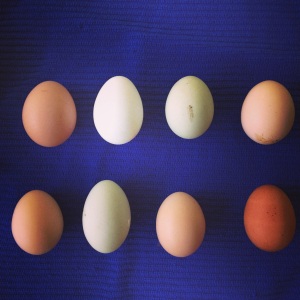As consumers, we tend to think that the label on our products are telling us something about what we are going to buy. When you go to buy a loaf of bread, reading the label is what might sway you in one direction or the other towards purchasing it. The problem is that most of the stuff you’re reading on that label is completely unregulated, and constructed carefully by a PR team to look a certain way so that you’ll buy it. The USDA does a decent job of regulating food so that it’s “safe” for us to eat, but not a good job of protecting the environment. Because it’s not the USDAs job to watch out for the environment, the regulations generally have nothing to do with humanity of raising the animals or the condition they’re living in – but mostly how the animals is processed before it gets to the grocery store. When it comes to eggs, I find these terms to be quite misleading.
Not too long ago I really had no idea about any of this, and when I would buy eggs from the grocery store I would just pick the ones with the most hot phrases on the carton like “cage free” “free-range” “natural” or whatever other nonsense it would say. When I started working with a local farm I was given a dozen eggs one day from their farm chickens. These chickens live in the orchard on the farm. They have a coop to go into at night, but throughout the day they have plenty of space to roam freely.
First off, the eggs from these chickens had the most vibrant orange yolk. The color of the yolk has a lot to do with what the chickens are eating on a daily basis. At Birds and Bees Farm these chickens are eating whatever is naturally available to them. They eat the bugs from the fruit, the grass and pick their way through the soil.

From Left to Right- 1. Fred Meyer “Simple Truth” Organic 2. Trader Joes Cherry Lane 3. Farm Fresh Chicken Egg 4. Farm Fresh Duck Egg
These chickens are free range and cage free, and that has nothing to do with any USDA regulation. So what are these regulations? Straight from the USDA website –
Free-range. This label indicates that the flock was provided shelter in a building, room, or area with unlimited access to food, fresh water, and continuous access to the outdoors during their production cycle. The outdoor area may or may not be fenced and/or covered with netting-like material. This label is regulated by the USDA.
Cage-free. This label indicates that the flock was able to freely roam a building, room, or enclosed area with unlimited access to food and fresh water during their production cycle.
Lets look first at what “free-range” really means. According to the definition above, chickens must be provided shelter with unlimited access to food and water with continuous access to outdoors. You see how it says “access” to outdoors, not “living in an outdoor environment”. This means that a warehouse jammed-packed with chickens, food and water bowls, and a patio they can go onto is considered “free-range”. I spoke to the farmer at Birds and Bees, and he told me that a lot of the big chicken farms have a small patio that the chickens can go onto, but since there’s no food or water left outside, they have no reason to go out there. It’s not like a grass patch full of bugs the chickens are free to roam – it’s simply “access to outdoors”. There is also no regulation as to how long the chickens are allowed access to the outdoors, just that they have it. This hypothetical egg farm is just as free-range as Birds and Bees chickens, says that USDA regulation.
When you see “cage-free” eggs, this means the chickens are able to freely roam. Roam freely? Doesn’t sound very regulated. Cage-free doesn’t even mean that the chickens need access to outdoors. If you took a warehouse full of caged chickens and then removed all the cages around the chickens, they would become “cage-free”.
It’s hard to think of these things, because when you see these terms on an egg carton they’re generally accompanied by a picture of cartoon chickens around a barn – relaxed, free and happy as hell to be supplying you with their eggs.
A lot of the time you can buy eggs from a farmers market for just as much as some expensive Whole Foods brand. This definitely doesn’t mean that every brand of eggs at the grocery store shouldn’t be trusted, but don’t be fooled by the labels. At the end of the day, eggs are just another product that a company is trying to sell you in order to make money.
Nothing beats buying local!
(article originally written for The Dirt on Organic Gardening)




Very interesting! Luckily my sister in law just got 5 chickens and will have plenty of eggs to share 🙂 I think one day we’ll have to get some too!
Outstanding content. Just what I ended up being looking around for!
All best,
ps
Check out your fresh SE stats at type in google lepsoft rankings